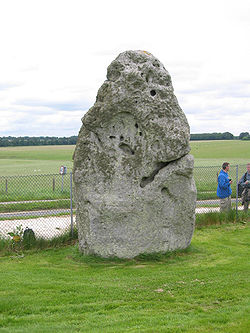
Heelstone Ditch
Encyclopedia

Heelstone
right|thumb|250px|Southwest face of HeelstoneThe Heelstone is a single large block of sarsen stone standing within the Avenue outside the entrance of the Stonehenge earthwork, close to the main road . In section it is sub-rectangular, with a minimum thickness of 8 ft , rising to a tapered top...
at Stonehenge
Stonehenge
Stonehenge is a prehistoric monument located in the English county of Wiltshire, about west of Amesbury and north of Salisbury. One of the most famous sites in the world, Stonehenge is composed of a circular setting of large standing stones set within earthworks...
. It is not known if there was an intended relationship between the ditch and the heelstone although it is likely that the stone was in place either before or at the same time as the ditch. It has steep sloping sides which end at a narrow flat base, and is approximately 4 ft (1.2m) deep and 3.5 ft (1.1m) wide. It is some 12 ft (3.7m) from base the base of the Heelstone, with a diameter of roughly 32 ft (9.7m). A broad arcing
Arc (geometry)
In geometry, an arc is a closed segment of a differentiable curve in the two-dimensional plane; for example, a circular arc is a segment of the circumference of a circle...
trench
Trench
A trench is a type of excavation or depression in the ground. Trenches are generally defined by being deeper than they are wide , and by being narrow compared to their length ....
found in 1923 by Lt-Col William Hawley
William Hawley
Lieutenant-Colonel William Hawley was a British archaeologist who most famously undertook pioneering excavations at Stonehenge....
9 ft (2.7m) wide cuts this ditch from the West, deepening towards the stone. Against the Heelstone Ditch (inside circle) is rammed chalk filled Stonehole 97, whose missing stone is known as Heelstone's twin although it is possible that the stone in Stonehole 97 was moved and is now the stone known as the Heelstone. The ditch was probably dug after the stone in Stonehole 97 was moved but possibly before that.ere was an intended relationship between the ditch and the heelstone although it is likely that the stone was in place either before or at the same time as the ditch.
Only a small part of the Heelstone Ditch, immediately behind the Highways Agency
Highways Agency
The Highways Agency is an executive agency, part of the Department for Transport in England. It has responsibility for managing the core road network in England...
A344 roadside fence, now remains unexplored or undisturbed. General nature of the ditch and fill described in 1979 by Michael W. Pitts, et al. http://www.britarch.ac.uk/ba/ba.html, compares well with Hawley's (1923, 1925).
Further reading
- Cunliffe, B, & Renfrew, C, Science and Stonehenge (The British Academy 92, Oxford University Press 1997)
- Newall, R S, Stonehenge, Wiltshire (Ancient monuments and historic buildings) (Her Majesty's Stationery Office, London, 1959)
- Pitts, M, Hengeworld (Arrow, London, 2001)
- Stone, J F SJ. F. S. StoneJohn Frederick Smerdon Stone was a British archaeologist, most famous for his work in and around Wiltshire, especially at Stonehenge and the Woodhenge area....
, Wessex Before the Celts (Frederick A Praeger Publishers, 1958)

